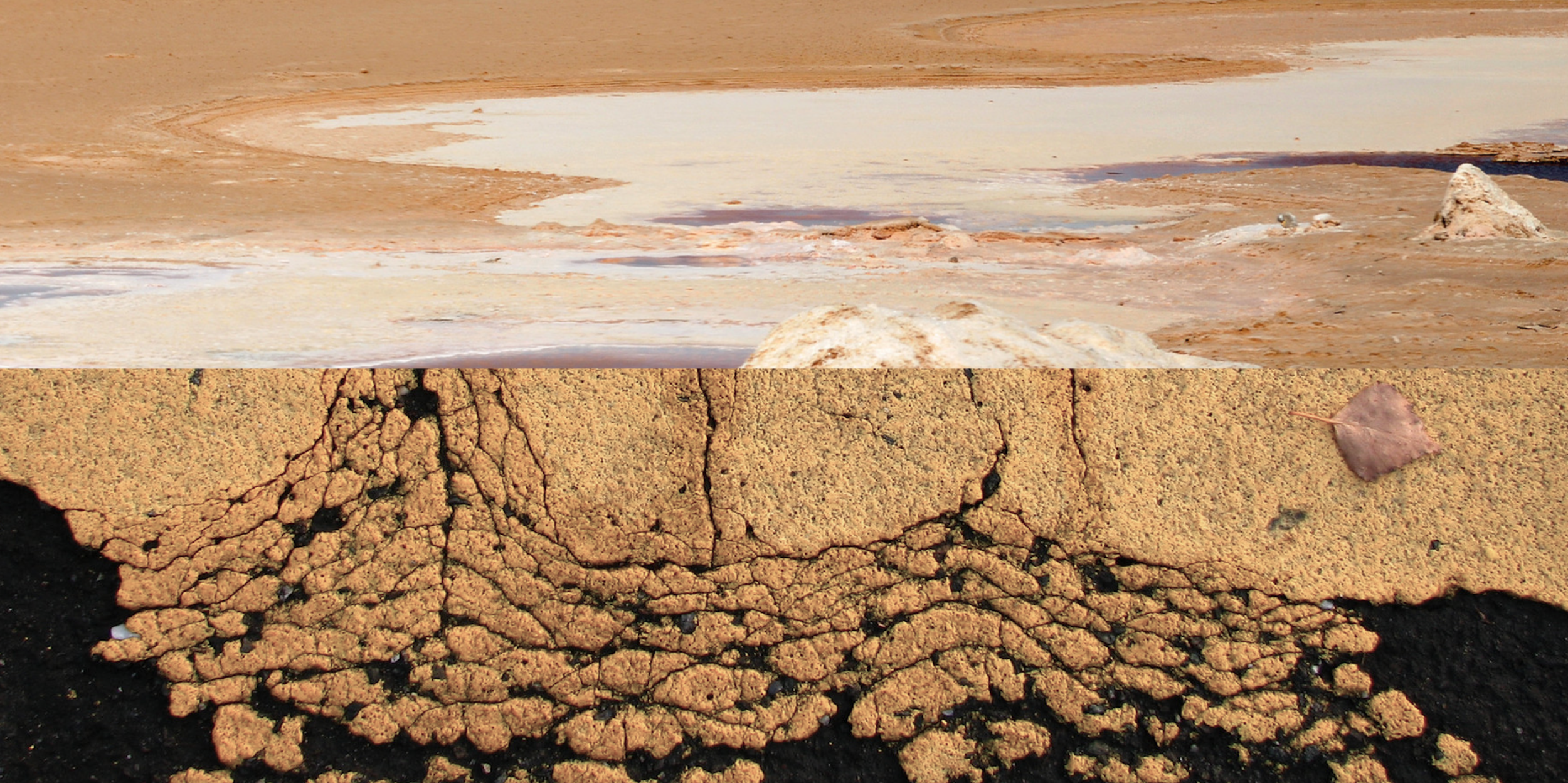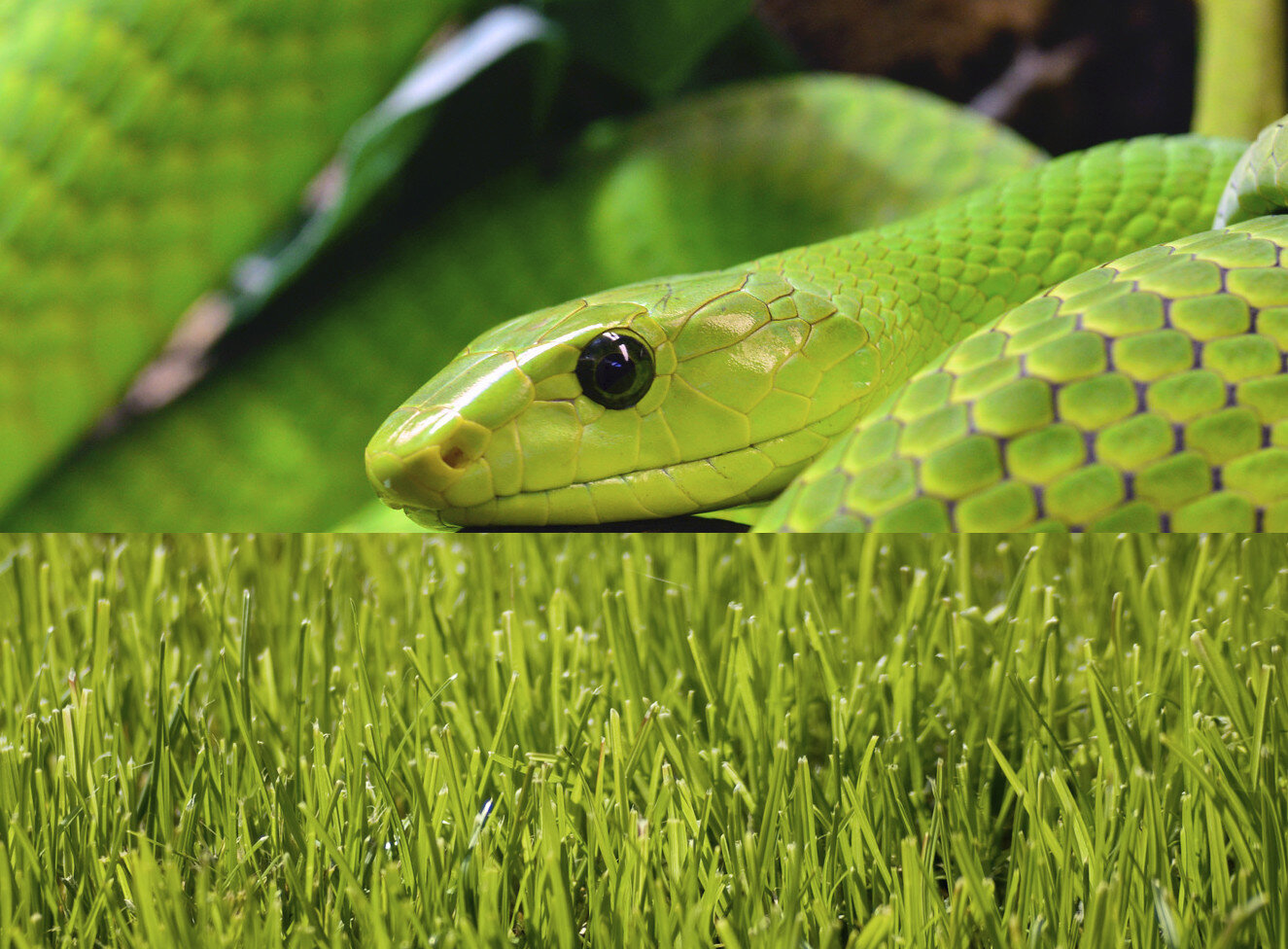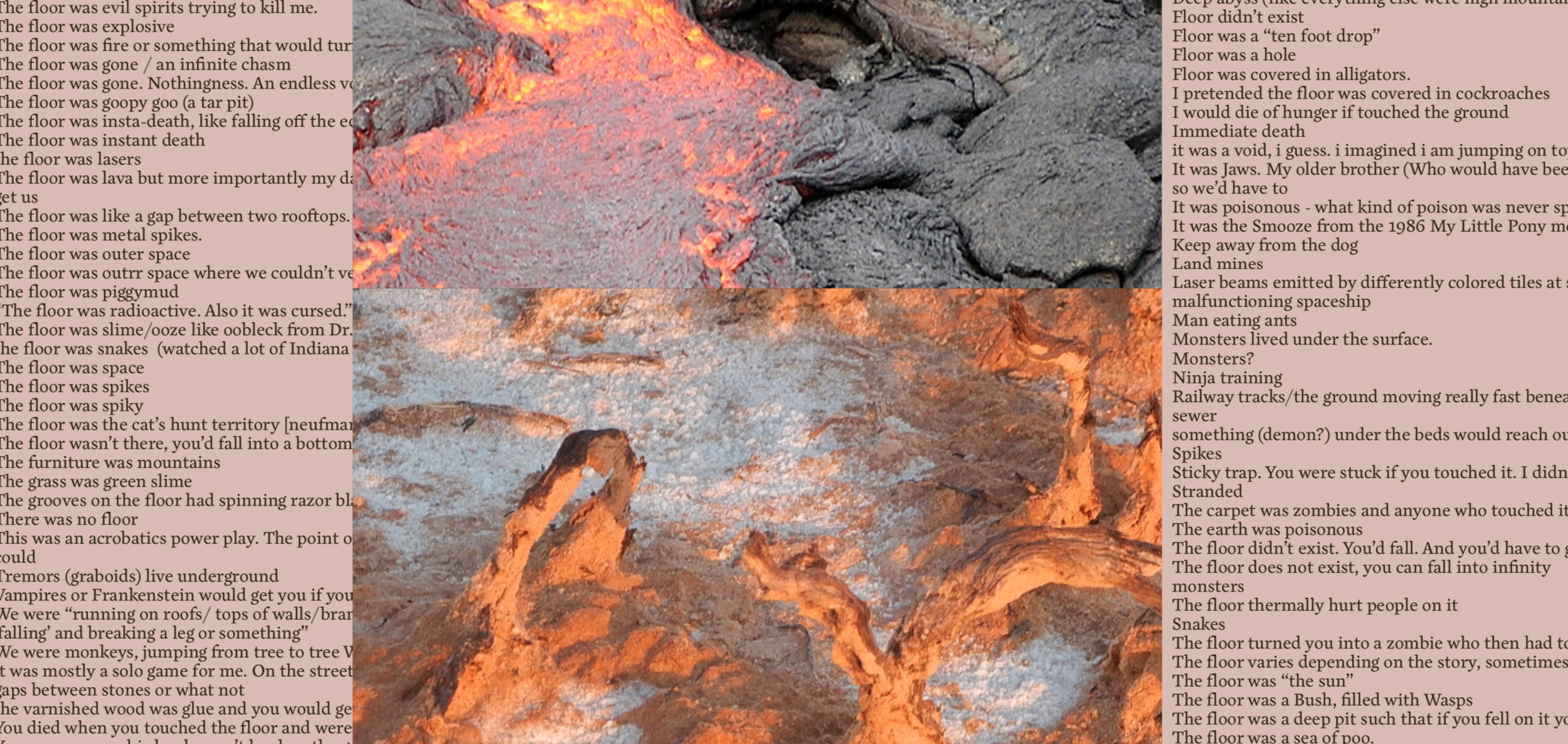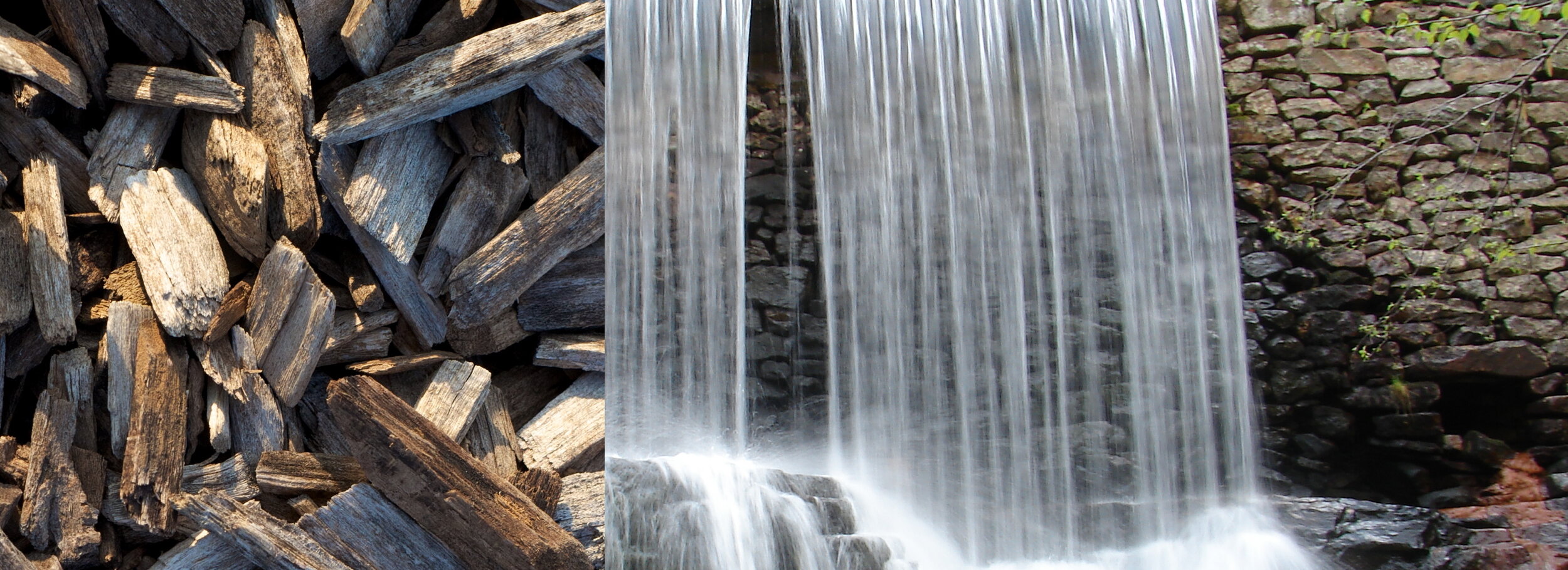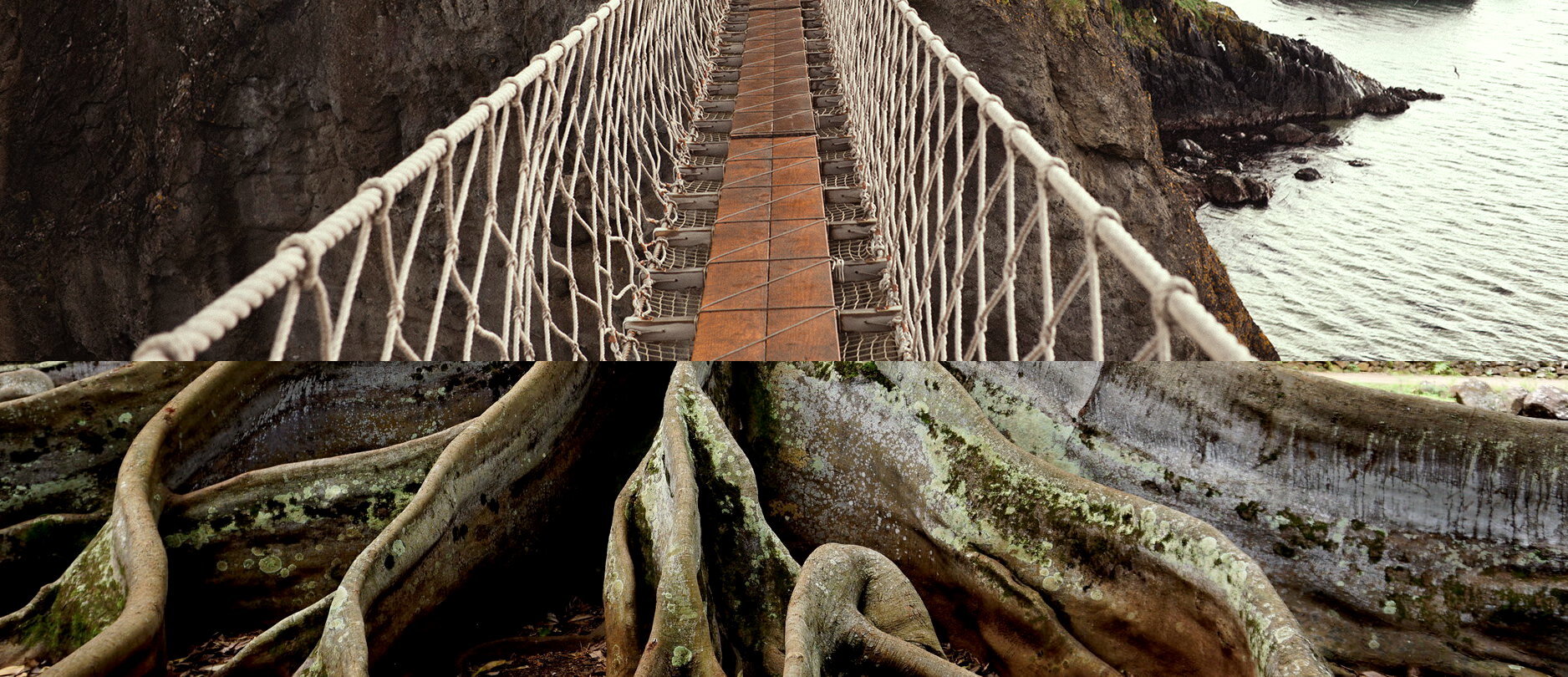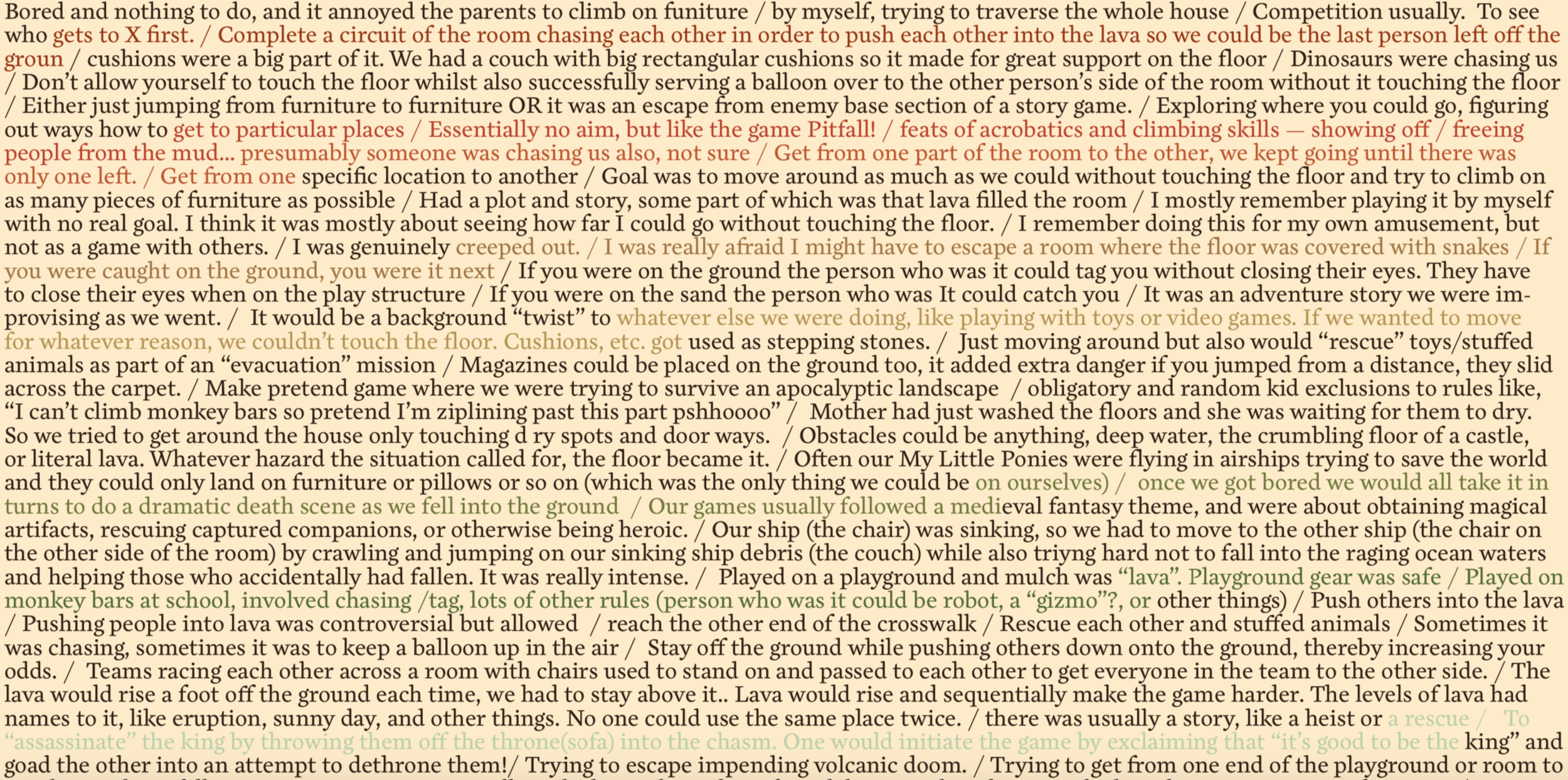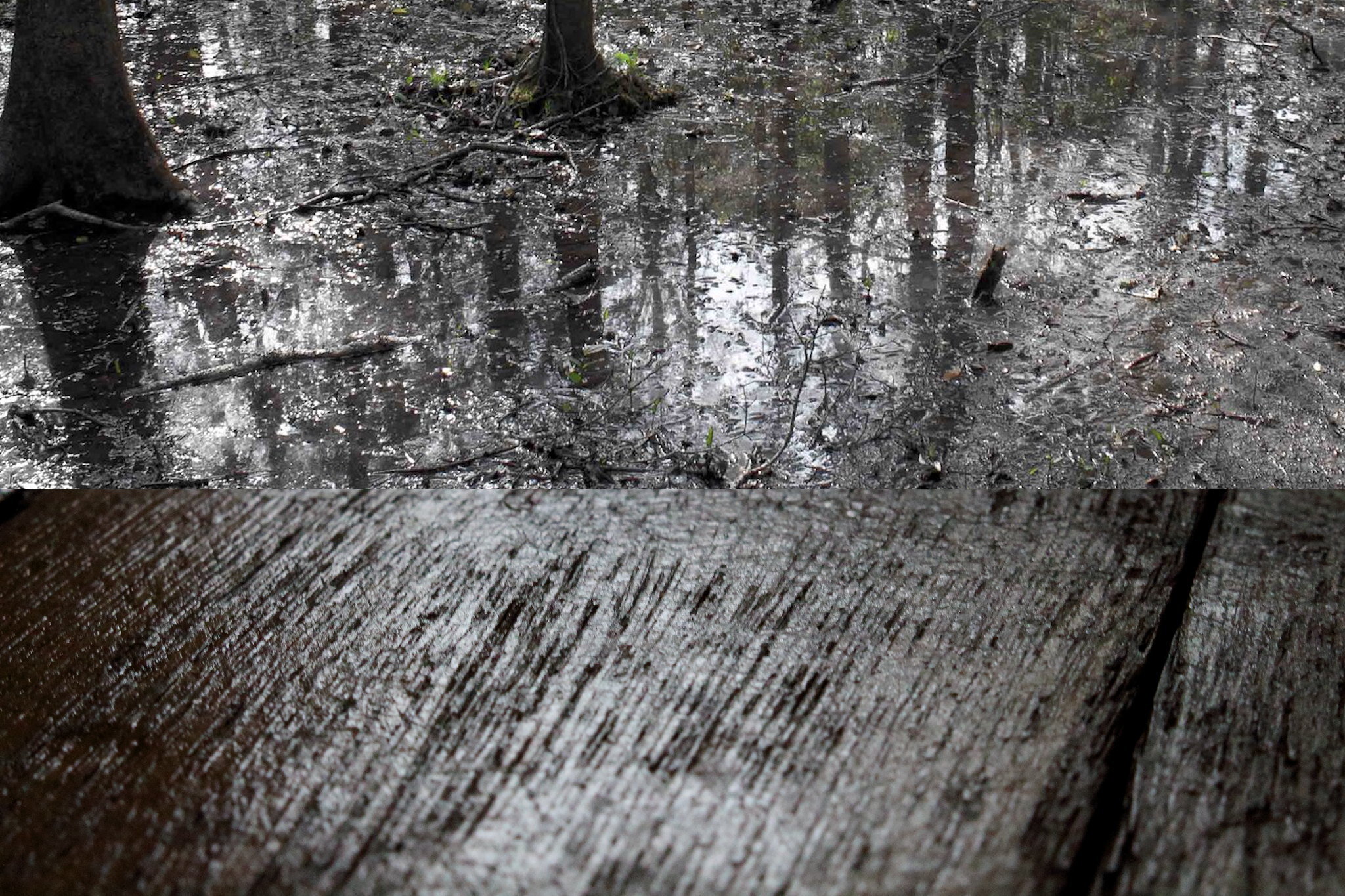The Floor
Kheng Cheng TOH: Carpet
My floor was never made of lava.
Usually my floor was made of quicksand. This was partly because of that one scene in The Princess Bride, but mostly because of going to the beach and feeling the wet grainy sand shift under my bare feet, wiggling my toes into it, imagining that this time—this time—it might suddenly give way. This time I might finally get to use all of my eagerly-acquired expertise in how to escape (throw away anything you’re carrying; sit or lie down to increase your surface area; free your trapped limbs slo-o-o-o-wly and clamber towards safety).
When my floor wasn’t quicksand, it was often water filled with sharks—it may not be a surprise at this point to learn that I grew up in Australia. (Though my floor was never spiders, which were too immediate a fear to have fun with.)
Occasionally my floor was matted with tree roots like the ones the girl falls through in Labyrinth. Or it was insta-death sand like the deadly desert from Ozma of Oz. Or it was gaps between delicate starry pathways like in Skymaze.
When I got a bit older, the ground stopped being made of anything in particular. Make-believe was for little kids. The ground was just: forbidden. The floor was: against the rules.
That was the 80s and 90s. Now, in 2020, the go-to term for games about avoiding the ground is one big phrase: “The Floor is Lava”.
Which is frustrating to me, the way that this name—and it’s a good name, evocative, clear—has started to overwrite all the other things that the floor could be. Surely, I thought, people who have lava floors are in the minority—or at least, surely they would be if the phrase “the floor is lava” wasn’t spreading so widely, flowing over other dangerous floorspaces, hissing over quicksand and piranhas and mysterious voids and rustling snakes.
So I ran a survey to find out what else the world’s imaginary dangerous floors are made of. And around 3500 people responded.
This essay is a collection of some of the things I found out when I went through their answers.
Dennis Jarvis Chott el Jerid / Lisa Ann Yount cracked crosswalk surface
First things first: what do you actually do when you play “The Floor Is Lava”?
“The Floor is Lava” is complicated to talk about because it’s not a single game. It’s a collection of behaviours, a set of changing rules, a bundle of connected ways that you can be weird about touching the floor.
One of the things we usually mention when we describe a game, especially a physical game like this one, is the aim—what are you trying to achieve? But I asked that question in the survey, and 55.3% of respondents said the game as they played it had no aim at all.
14.7% said the aim was to be the last person off the ground; 10.0% that it was to chase and catch each other. But even within this 10% there were dozens of variations. Some players said they played a normal chase game, except they had to stay off the floor completely. Others said they could move where they liked, but they could only be caught by the chaser when they were on the ground (a few people called this “off-ground tig”, and a few “lava monster”). Still other players described rules where players who fall to the ground would get “stuck”—and within this subsection of a subsection there was a division between players who could be freed by their companions, and players who became agents of the floor, reaching out to tag others as they climbed past.
So although we all know roughly what I’m talking about when I say “Floor is Lava games”, it’s a hard game, or category of games, to define. It encompasses everything from centrally-organised games in a school gym for forty players at a time to this, from one survey respondent:
when upside-down by Diana Ross came on everyone had to get up on anything near you and dance on it for the rest of the song
The unifying characteristic is: acting as though the floor is forbidden. Inverting the standard behavioural rules of the gym or yard or living room, where the floor is for walking on and the furniture is very much not.
That doesn’t always mean avoiding the floor. Sometimes succumbing to the danger is the pleasure: a tiny quick step onto the carpet and a squeal at the sting of the lava; reaching down with a courageous hand to tease the sharks. I remember sitting on the beige carpet of my bedroom and imagining the quicksand as it crept up slowly over my legs, and then up my body, around my waist and higher and higher while I grabbed on hard to the leg of my bed so I could haul myself out at the last minute.
As long as there’s some rules or pretence about what happens when you touch the floor, the game is something I’m interested in.
Hape662 Green Mamba / Pea Chesh Spring Lawn
Okay, so what do people actually pretend the floor is made of?
I’m not a statistician. I’m not even a researcher. I didn’t run a proper academic study with a hypothesis and a set of questions designed to test that hypothesis. I didn’t verify people’s answers to the survey. I just asked a load of questions about the floor—you can see the questions here, and even answer them, if you like—and then I looked at the answers.
But there were a whole lot of those answers: 3417, in fact. Most of the respondents, around 65%, were from the US; another 20% or so were from Australia, Canada or the UK. Overall there were a lot of respondents based in English-speaking countries, which is what you’d expect from a survey conducted in English and distributed via the methodology of “people I know retweeting it”.
So, sure, not a representative sample of the world.
Still, 3417 people. It’s a lot! It’s enough to make some interesting trends visible, to allow me to experiment with a few ideas, enough to bolster or dispel a few suspicions.
Like this one: if I had a theory going into the survey it was that the floor would turn out to be way less lava than the dominance of the floor-is-lava narrative suggests.
And my headline results are: I was wrong. Here’s the stats on how people answered the basic question “why couldn’t you stand on the floor?”:
| Reason | Percentage |
|---|---|
| Lava | 72.28% |
| No particular reason | 7.06 |
| Water | 5.06 |
| Sharks | 3.31 |
| Quicksand | 2.96 |
| Crocodiles or alligators | 2.08 |
| Chasm | 1.35 |
| Poison | 0.88 |
| Electricity | 0.64 |
| Fire | 0.44 |
| Piranhas | 0.35 |
| Shark-infested custard | 0.26 |
| Swamp | 0.18 |
Lava is the clear winner at 72%, with variations on water (just plain water, water with sharks, water with crocodiles, water with piranhas) taking up another 11% or so. The only other big winners are “Quicksand” (just under 3%! Three cheers for my quicksand buddies, friends of my heart!), and the 7% who didn’t have a reason other than “well, you’re not allowed to”.
It’s worth noting that “poison” and “fire” are probably underrepresented here. They weren’t tickbox options that I offered as part of the survey; they were just really successful write-ins. And there’s plenty of evidence that some people forget what their floor was made of until they’re reminded: I had a lot of respondents making comments like “oh, I forgot about piranhas!”. So “poison” and “fire” would have done better if I’d thought to make them a core survey option.
But between the options I provided, and those two write-ins, the list above covers 97% of everything that the floor might be made of. Other write-ins helping to fill out that final three percent included:
an abyss, acid (x4), aliens out of the Alien series, ants, black devouring liquid, boiling oil, a bottomless pit (x4), a bush filled with wasps, cat’s hunting territory, cockroaches, cold, cursed, death, death itself, immediate death, deep pit, demon, desert, dog, endless void, evil spirits, fire, glue, graboids from the film Tremors (x3), green slime, heat, hunger, infinity, Jaws, land mines (x2), lasers (x2), malfunctioning spaceship, man-eating ants, monsters (x5), ninja training, nothingness, ocean, plague, poison where you would instantly dissolve and die somehow, poo (x2), radioactivity, railway tracks, slime like the ooblek from Dr. Seuss, the Smooze from the 1986 My Little Pony movie, snakes (x3), something that would turn you to stone/ice, space (x3), spikes (x5), spinning razor blades, sticky trap, sewer, the sun, a tar pit, and zombies (x2).
Lava and basalt Scot Nelson / Salt and dirt shapes Michael Coghlan
Outside the US, everything looks a bit different.
So, if 72% of floors are made of lava, then that’s a whole lot of lava. But those results are skewed by the huge number of survey respondents from the USA, where the floor was lava for an even higher proportion of players: just over 85%. In other countries, things are different. In some places, lava is less common, but still dominant; in others it’s all but unknown—one respondent who played in Malaysia in the 90s, for example, said, “The floor was ‘fire’, because children who grew up here in my time didn’t really have the concept of volcanoes or lava”. (I only got three respondents from 1990s Malaysia, but it’s true that none of them had lava floors: of the other two, one had quicksand and the other just floors that were generally forbidden).
Here’s the countries where at least 15 people responded to my survey, and how many of those respondents had lava floors:
| Country | Lava dodgers |
|---|---|
| United States of America | 85.4% |
| Canada | 72.6 |
| Australia | 66.2 |
| Ireland | 56.1 |
| Germany | 50.0 |
| The Netherlands | 45.0 |
| Russia | 44.4 |
| United Kingdom | 43.6 |
| France | 22.7 |
| Denmark | 16.6 |
| Sweden | 15.8 |
Countries that didn’t hit that 15-responder cutoff came in at, on average, around 45% lava; across the world, excluding the USA, lava floors are at about 50%. And there are plenty of countries where something other than lava tops the rankings. In Denmark, 64% of respondents report that their floor was poison; the game is widely known there as “Jorden er Giftig”, the ground is toxic, the earth is poison. In France: 25% crocodiles and alligators. In Russia, 25% “no particular reason” then 15% “chasm”. In Spain: just under 40% water. In Sweden, they’re very sensible and don’t need a pretend reason to avoid the floor: 48% of respondents say their floor wasn’t anything in particular, they just weren’t meant to step on it. The full breakdown if we exclude all US respondents looks something like this:
| Reason to avoid the floor | Percentage |
|---|---|
| Lava | 49.9% |
| No particular reason | 13.8 |
| Water | 8.9 |
| Sharks | 6.3 |
| Crocodiles / alligators | 3.9 |
| Chasm / vortex | 2.7 |
| Poison | 2.4 |
| Quicksand | 1.2 |
| Electricity | 1.1 |
| Fire | 1.0 |
| Shark-infested custard | 0.7 |
| Piranhas | 0.6 |
| Swamp | 0.5 |
| Death | 0.3 |
And here’s the top three floors for countries that had more than 10 survey respondents. (It’s worth noting that for the countries with smaller numbers of respondents, the third-place floor was in some cases listed by only one or two people.)
| Country | Most popular floor covering | Second most popular | Third most popular |
|---|---|---|---|
| Australia (77 respondents) | Lava (66%) | No reason (9%) | Quicksand (5%) / Water (5%) |
| Canada (204 respondents) | Lava (73%) | No reason (9%) | Sharks (3%) |
| Denmark (42 respondents) | Poison (64%) | Lava (17%) | No reason (2%) |
| France (44 respondents) | Crocodiles / alligators (25%) | Lava (23%) | No reason (18%) |
| Germany (58 respondents) | Lava (50%) | No reason (24%) | Water (14%) |
| Ireland (57 respondents) | Lava (56%) | Quicksand (9%) | Water (7%) / Sharks (7%) |
| Netherlands (20 respondents) | Lava (45%) | Crocodiles / alligators (25%) | Water (15%) |
| New Zealand (18 respondents) | Lava (72%) | No reason (17%) | Chasm (6%) |
| Norway (19 respondents) | Lava (74%) | Water (16%) | Piranhas (5%) / Electricity (5%) |
| Russia (27 respondents) | Lava (44%) | No reason (26%) | Chasm (15%) |
| Spain (13 respondents) | Water (38%) | Chasm (15%) | No reason (15%) |
| Sweden (38 respondents) | No reason (47%) | Water (18%) | Lava (16%) |
| United Kingdom (459 respondents) | Lava (44%) | No reason (14%) | Sharks (11%) |
| United States of America (2187 respondents) | Lava (85%) | No reason (3%) | Water (3%) |
As you can see, the countries where English is an official majority language are lava-dominant, if not to the same extent as the USA; other countries (even countries where most people also speak English) are more likely to have a different set of results. If I’d managed to get respondents from a wider variety of countries, especially non-Anglophone countries, then it seems like probably I’d have found an even wider variety of floors.
What does this all mean? Well, it’s good evidence that people aren’t generally coming up with the game spontaneously, and that most of the many children who think they “invented” it didn’t: they must have learned it from friends or family members or play leaders, or there wouldn’t be so much geographical clustering. A Reddit discussion posits that perhaps the American lava tendencies come from the US’s interest in Hawai’i and other Pacific islands from the 50s and 60s, following Hawai’i becoming a state in 1959. Later on in the discussion, a commenter who grew up in Hawai’i mentions that their floor wasn’t lava until after they’d moved, because before that, lava felt like too real a danger:
I grew up on the Big Island of Hawai'i before moving to the mainland. I didn't play "lava floor" with my friends; among other reasons, it was seen as slightly blasphemous and tempting fate to insult Pele. We played "acid-floor" or "ice-floor" or "black hole warping the remains of the spaceship's hull into a deathly state-floor", and after I moved to an area where lava wasn't a concern it became "lava floor".
So, so far we know that different places tend towards different dangerous floors, but that nowhere is totally unanimous about what their floors are made of. We know that lava is common, but not dominant everywhere. And we can have some anecdotal hints that perhaps the ideal dangerous substance is one that the floor-dodger is familiar with on a conceptual level, and that exists in the wider culture around them, but not something they perceive themselves to be genuinely at risk from in their day-to-day life.
a.canvas.of.light Hyperjump / Daniel X. O’Neil Detail of Tile Floor
The past is a foreign country: their floors are made of different imaginary substances.
When I ran the survey I initially wondered whether the dominance of lava might have something to do with its role in videogames, where it’s a go-to Dangerous Surface. Perhaps, I thought, there’d be an increase in the lava-ness of floors from the 80s, corresponding to the growth in home videogame consoles? But that’s just another theory that didn’t quite pan out once I had the numbers. It’s true that there’s something of an arc to the popularity of lava, with lower levels in the 1950s and 1960s (though the survey received fewer responses from that period, and none from earlier, so the Reddit theory about the influence of Hawai’i’s newfound statehood could still hold up). Worldwide, lava peaks in the 90s at over 75%, then declines a little. If we look at the data excluding the US, then it’s more marked—a really clear increase in lava-ness over time, and a corresponding decrease in the cluster of floor surfaces around water (water, sharks, crocodiles, piranhas and so on).
Percentage of floors that were made of particular substances, by decade
Incidentally, there are other differences between decades: it’s not just the nature of the floor. For example, over the decades, it’s become more and more okay for players to use pillows or papers or blankets or chairs to create steppable islands on the floor:
Percentage of respondents who permitted the use of cushions, chairs etc as islands
(That drop at the end is probably because most of the survey answers from the 2010s come from parents answering on behalf of their children, and parents are naturally more likely to consider the question of whether the children are permitted to step on thrown cushions by the rules of the household; this factor is often only tangentially related to whether the children are permitted to step on thrown cushions by the rules of the game.)
Josh Puetz Abstract Chips / Jen waterfall
What about the rest of history?
Okay, so my survey respondents took me back as far as the 50s and 60s. What about before that? Where does the game even come from in the first place?
Well. It’s a difficult game to trace back. Children’s games aren’t very well documented, especially before the late 19th century; and the fact that the game doesn’t have consistent rules or a reliable name makes it even harder to track. What do we even mean by “the game”, right? This isn’t a single ruleset: it’s a bunch of related ways to treat the floor.
But there’s no reason to believe that “avoiding the floor playfully” doesn’t go back a very long time, even if the evidence is scattered. Primo Levi notes, in 1980 in“The Children’s International”:
Almost all ‘catch’ games provide for a sanctuary (given different names: among us it is ‘the touch’) in which the pursued is safe from capture; very popular is the variation which in Italy is called ‘high up’ and forty years ago ‘porter’s lodge’, which in France is ‘le chat-perché’ (the perching cat) and in England ‘off-ground he’: incidentally, ‘he’ or ‘it’ is the player whom we Italians call ‘under’. In this version safety is achieved simply by climbing on any surface that projects above ground level. ‘Higher up’ is known all over the world.
“Off-Ground He” or “Off-Ground Tig” is documented back to at least Norman Douglas’s London Street Games in 1916, quoting a player here:
“You are not supposed to let your feet touch the ground, if you do, the one who is out can have you”
Levi also mentions, as a member of the family, “Chat Perché”, a French game whose name means “Perched Cat”; the earliest reference I’ve been able to dig out on this particular member of the floor-is-lava family is from 1875’s Les jeux de collèges, but the book talks about it as if it’s old and familiar. We can perhaps draw a relationship here between the perching cat and “Puss in the Corner”, an even older English game where players try to run between corners (which are safe) without being caught: in some versions of the game, each “corner” has a chair to stand on, or there are benches lined up along the walls. And see, for example, this later version from Jessie H. Bancroft’s 1922 Games for the Playground, Home, School and Gymnasium.
This game may be very delightfully adapted to outdoor play by each player taking a tree as a “corner,” when the dodging and running may be much more varied and interesting than in the open space of a parlor or gymnasium.
No clear lineage, then, but enough scattered examples that we can be sure that there have been games about climbing up off the floor for at least as long as we have decent collections of children’s games, and probably much longer. But what about the other key part of “The Floor is Lava” and its family: the pretence that the ground is something other than it is? That’s the bit I set out to investigate, after all: what is it that people pretend the floor is made of? How does that change over time?
Imaginative play is even more poorly recorded than games with rules; the versions of any game that are recorded are usually the “game”-iest versions, because the structures people impose and follow are always better documented than the things they pretend. Of course children around the world must have been pretending that the floor is something dangerous for a very, very long time, but the oldest documented example that I’ve found is from H.G. Wells’ 1911 Floor Games—he’s talking here about playing with toy soldiers with his sons:
With the larger ones we make islands and archipelagos on our floor while the floor is a sea, or we make a large island or a couple on the Venice pattern, or we pile the smaller on the larger to make hills when the floor is a level plain.
In Astrid Lindgren’s Pippi Longstocking, from 1945, we finally get that perfect combination of both pretending the floor is something else and trying not to step on the floor. In this case, just like with H.G. Wells, the floor is the sea:
Then it was time for games. Pippi suggested they play one called Shipwrecked. It was very simple. All they had to do was make their way round the kitchen without putting a single foot on the floor. Pippi scuttled round in a flash, but Tommy and Annika did quite well too. They started on the draining board and if they stretched out their legs as far as they could they could get to the stove, then from the stove to the log box, the log box to the hat rack, down on to the table and from there over two stools to the corner cupboard. Between the corner cupboard and the draining board there was a distance of several metres, but luckily that’s where the horse was standing and if they climbed onto his back at the tail end and slid along to his head end, and just at the right moment made a jump for it, they would land on the draining board.
This passage made a big impression on me; I remember sitting in the kitchen when I was six and trying to figure out what my path around it would be, although in the end I wasn’t naughty enough to climb on the sink or brave enough to swing on the door from one cupboard to the next. Next comes Roald Dahl’s “The Wish”, first published in 1953 in Someone Like You. (Neither the Lindgren nor the Dahl are original discoveries with me: plenty of online conversations about “The Floor is Lava” have brought them up.)
He picked up the scab, put it on his thigh and flipped it with a finger so that it flew away and landed on the edge of the carpet, the enormous red and black and yellow carpet that stretched the whole length of the hall from the stairs on which he sat to the front door in the distance. A tremendous carpet. Bigger than the tennis lawn. Much bigger than that. He regarded it gravely, setting his eyes upon it with mild pleasure. He had never really noticed it before, but now, all of a sudden the colours seemed to brighten mysteriously and spring out at him in a most dazzling way. You see, he told himself, I know how it is. The red parts of the carpet are red-hot lumps of coal. What I must do is this: I must walk all the way along it to the front door without touching them. If I touch the red I will be burnt. As a matter of fact, I will be burnt up completely. And the black parts of the carpet... yes, the black parts are snakes, poisonous snakes, adders mostly, and cobras, thick like tree-trunks round the middle, and if I touch one of them, I’ll be bitten and I’ll die before tea time.
Now we’re getting somewhere. No lava yet—in fact, I haven’t found any evidence of lava floors dating from before the 1950s lava that some of my survey respondents report—but a good clear encapsulation of the game.
styrovor Carrick-A-Rede Rope Bridge / im me Dino Tree
The Actual Real-Life Floor Matters, Too
This emergence of the game’s specific details from the characteristics of the furniture arrangement (in the Lindgren) and the carpet patterns (in the Dahl) feels particularly important to me.
Sure, the social context of a game matters, but the actual physical space that people are playing in matters too.
Perhaps there are suggestive patterns on the floor; perhaps there are chairs you’re allowed to climb on or a soft place to fall near some benches. When I wrote the survey, I was at home in London; as I wrote, our large blue rug below me made me think about treacherous lakes, and I dipped my toe in it a couple of times.
But as I write this summary, I’m in Adelaide, sitting above glossy floorboards. I’m now an adult with a weak left ankle, and there’s a pandemic on so it’s a bad time to be going to the hospital, so it’s not like I’d be clambering over the furniture all that much anyway. But even if I were, the floor here is all wrong to be lava or a lake, and the furniture is too sparse to jump from piece to piece. Maybe a version of the game where the floor is a bowling alley, and climbing is safe but if you step on the floor then you slide uncontrollably in the direction you’re going until you hit the wall?
There’s a neat paper by Tim Hwang called “On the Architecture of the Folk Game: The Case of ‘The Floor is Lava’”, which argues that the Floor-is-Lava game arises spontaneously out of the affordances of its environment, and that the growth of the family room in the post-war American home is part of why it’s so popular today. The game is a natural one to invent in the right circumstances, but those circumstances require—Hwang suggests—not just a space the right size to jump around, with a suitable supply of furniture and ideally movable items like pillows; but also that that space be either okay to jump around in, or sufficiently unreliably supervised that you can jump around even if you’re not technically supposed to.
And it’s obviously true that “The Floor is Lava” and its variants are games that can arise from a particular sort of environment: that although the games spread from child to child (as the geographical clustering of the themes shows), they’ve also been created spontaneously many many times based on the peculiarities and specifics of a given place. Hwang points to members of the family like Mtezo, a “ground-avoidance game” discussed in Mwangi Peter Wanderi’s 2011 The Indigenous Games of the People of the Coastal Region of Kenya: A Cultural and Educational Appraisal, where children swing from ropes fixed to trees or—in suitable environments—from naturally-occurring lianas and flexible branches. Compare to this tree example from an anonymous UK responder:
There was a big tree in the playground of our primary school with a thick trunk and big gnarled, lumpy roots. Around the roots was a sort of worn-away pit of dust and dirt, pretty evenly circular in the grass, and my friends and I would clamber onto the roots and climb our way around, using whatever hand/footholds and weird shapes in the tree we could find to stay on, just doing loops around the tree. Sometimes we'd try to push each other off while going round and see who could stay on longest, or we'd go in opposite directions and have to pass each other without falling. I remember bits of the tree being really smooth and polished from being climbed on. Went back a few years ago and it was all grown over with grass again, the dirt pretty much gone and the roots half-hidden.
Or see this, a little different, from a respondent who played in 1990s Costa Rica:
we sometimes played outside […] climbing on trees, stepping on treestumps and rocks
The wider environment can affect the game as well: see this from 1990s Denmark, which uses trees but also irregular prompts in the environment as a cue to start playing, like that “when Diana Ross comes on” right back up at the beginning of this essay:
After the original game, the earth is poisonous, we created a game in school. There would be a train passing by, close to the school. We created a game where, whenever we could hear the train getting near and we were outside in a break between classes, we couldn't touch the ground when it passed by, because the ground would be "electrified". So we would stop whatever we were doing and run to the forest, for example, jump onto a tree and stay there until the train had passed by. Then we could go back to whatever we were doing again.
The play environment enables and limits the actions you can take, and therefore shapes the rules. And it shapes the pretence as well—see this for example, where the shifting sunlight and shade of a hot summer both creates the changing environment for play, and supports the pretence of lava:
I more vividly remember a version of the game my brother and my cul-de-sac friends played outside where you start at one end of the street and move to the cul de sac faster than anyone else. The rules were you couldn’t step in the light (move in the shadows). We’d usually play this game on cloudy days so there was a few seconds of rolling shadows on the ground cast from the clouds, and the peaking sunlight would surprise you as the clouds changed shapes. One reason I remember this so well was that in the summer in Texas the sunlight is rather hot, and the brief shade is rather cool, so it gives you sensation to back up your imagination that you’re avoiding lava/fire.
Patterns of tiles and carpeting do a similar thing:
The floor was alligators ONLY at one particular grocery store because it had stripes of green tiles in the flooring.
This comes up over and over again in the survey responses: floors where a particular texture or pattern or colour is cited as the reason for a particular pretence, even for people whose floors were usually made of a different material. Even the most dedicated lava jumpers struggle to pretend that a blue floor has been flooded by a volcano; my own quicksand childhood must have been influenced by the sandy carpet.
The floor is from that movie you saw that time
So, we decide what the floor is based on what other players of the game say. (For respondents to my survey, this was almost all about immediate peers of the players; for kids now, tiktoks and other online video sources surely have an influence as well.)
Or we get inspired by the specifics of the environment: hot pavements are more likely to be fire, blue rugs more likely to be water.
The final major source of inspiration for floor materiality is: stories. Television and games and movies and books. I’m not talking about characters in a story who are shown playing the game, but rather characters who have to contend with in-world fictional dangers, which players then take out of that fictional world and superimpose onto their own floors.
A lot of survey respondents were really, really clear not just on what they thought the floor was made of, but where that idea came from, why it stuck in their head: for me, like I said at the start, The Princess Bride and Labyrinth and Ozma of Oz, I guess because they have secrets and mysteries and adventures and also women in fancy dresses.
One anonymous respondent said:
I think I only played Super Mario once but it made a huge impression and informed a lot of my navigating-obstacles play.
Another, showing I’m not alone in my influences:
Desert that would turn me into sand (I think it was from an Oz book?)
It was from an Oz book! Another:
The Smooze from the 1986 My Little Pony movie.
Another still combines a fictional inspiration with the influence of a tile pattern:
Our main variant of this was based on a scene from the Ducktales movie where they have to avoid a security system by only stepping on tiles of a certain color on a checkerboard. Our local Shopko had semi checkerboard floors so any time we were there we played that version.
There are dozens of these examples: players imagining floors made from something they’re conceptually familiar with, through a movie or a game, but maybe haven’t encountered in the real world. Something they’ve had presented to them as terrifying in principle, but which they don’t expect to have to contend with as part of their everyday life. The safe sort of scary.
Tim Conway Muddy swamp / James Waine Wood flooring
Playing along or playing alone
There’s a bit of me that feels like I should have some sort of rousing conclusion, a call-to-arms against the hegemony of lava.
I even tried writing it, but it didn’t quite ring true. In fact, I feel a lot friendlier towards lava than I did when I started the survey; more willing to believe that lava and other floors can coexist.
But I do want to end by appreciating people whose floors are stranger and more varied, and in particular one group of players: the people who played alone.
When I asked survey respondents who they played the game with, a lot of the answers were pretty much what you’d expect: the girls at the playground, a group of siblings, a dozen cousins, a mixed-gender after-school group, that kind of thing.
But some people said they’d played alone. And that’s really interesting to me, because kids who played alone are obviously less likely to have received their ideas of what the floor was from from anyone else. Might that be reflected in a lower frequency of lava?
Yep: sure enough, only 26% of kids who played alone thought that the floor was lava. That’s way, way below the 76% overall average.
However, a lot of these solo players were kind-of… apologetic about playing alone. They left little notes in their answers saying things like “I was weird and I played this on my own” or “I played by myself at home :(“ or “just me, sorry!”. And I think it’s important—especially when so many more people are having to stay in their houses and find fun where they can, or play alone without company—to note that playing alone isn’t something weird or wrong.
I think we feel, culturally, like physical play is “meant” to be communal, and that childhood games are meant to be something you do with friends—so some of the people who played by themselves now feel, looking back, like they were doing it wrong, or might not be the sort of players I’m interested in. (The way I phrased my questions probably didn’t help.)
But playing this game on your own is actually really common! Why wouldn’t you play it on your own? It’s fun, it’s simple, it’s responsive to the environment, it’s physical, it’s a new way to understand your surroundings.
Communal play, the sense of joining in and constructing rules and a play world together, is great, but it’s not the only great thing about play.
One of the other great things is invention, and that’s where the solo players really shine. Their floors came in at only 26% lava, like I said; around 10% water, 10% bottomless chasm (much higher than the average for bottomless chasms). And 16% of them had floors made of something unusual, a write-in that wasn’t included in my survey: over five times as many weird floors as kids who played in groups. If you play on your own, your floor is made of whatever you want it to be.
Thanks to everyone who answered the survey, including @FossilizedDev, @irishstu, @jaytorres, @MoeAlhassan, @pyjamads, @tabaquaberry on twitter, @valwyn, A.J. Fox, Aaron, Aaron Elswicjk, Aaron Sullivan, Abby Davis, Adam Yim, Adele, Adrian, Agoaj, Aksel Wester, Alex Fleetwood, Alexandra, Alexandru Ene, Alexis Goble, Alfredo Perez, Alice, Alison, Alison Davis , Alistair, Allison James, Amanda, Amanda Fox, Amani Naseem, Amparo Arnold-Garza, Amy Christison, Anders Jensen, Andrea allemann, Andrew Johnson, Andrew Plant, Andrew Ryan, Andrew Spencer, Andrey Efremov, Andy Runyon, Anna Weinand, I don’t care if I’m credited or not, Anne, Anthony Mikos, Ariel Sebastián Becker, Aron T, Audrey Cheng, Barry from 1980s Milwaukee, Beau, Bendix, Bernie Bays, Beth Cato, Bill Collins, Bill Crosbie, Bill Emerson , Bill R., Bill R., Bjørnar Bugge, blaniolioni the bold, Brady, BRC, brendan, Brent Byington, Breogan Hackett, Brian Enigma, Brian Hamilton, Brian K, Briana Murray, BronxKuma, Bruce, C Jones, C Stantis, C. Goscinski, Caleb Martin, Cami, Carol Gilbert, Catriona, Charlie Bones, Charlie Curran Jones, Charlotte M. Ellett, Charlotte Trible, Cher Scarlett, Chris, Chris Frystak, Chris Haffner, Chris Locher, Chris Pheasey, Chris Vaughn (Reload Last Save), Chuck LaPress survivor of many leap of death challenges, Ciara Clark , CJ, CJ Midwood, Claire Avery, Claire Gilligan, Clovelt, corey, cormac, Crass B’stard, Cree Toner, Curtis Perry, Dalton King, Dámhín, Dan, Dan, Dan Bjork, Dan Martinez, Dan Parkes, Daniel , Daniel E. Olesen, Daniel Watson, Dave Williams, David E. Wheeler, David K, David L. King, David Sagus, David Smith, Dee, DemonTomatoDave, Dennis C, Dermot, Diego Fajardo, Don Denton, Doria, Eli, eli fessler, Elinor, Elizabeth Fazzio, Ellie Martin, Emily , Emily Flynn-Jones, Emily Johnson, Emily Robin Goudy, Emma Charleston, Emma Edwards, Ender, enINFAMOUSvy, Erika, Farhana , Fatima Shaikh, Fermin Diaz, fogus, Francis Davey, Freedom, FreeMorpheme, Freya, Gabi, Gabi, gale winter, Gareth Alexander, Gaurav Sethi, Gemma, George the Archon, georgia, Good Tweetman, Grace, Greg , Hannah C. Gunderman, Harry Willmott , Hexagonapus, Ian McD, Igor K., Innes, Insert Name Here, Isabel, Isabel McKenzie, Isobelle, Jaclyn W, Jacob Zielke, Jacopo, Jae Benn, Jajandio, Jake Burns , jakob, James Curtis, James D, James Peel, Jamie, Janelle, Jarryd Huntley, Jason de Parrie-Turner, Jay, Jay Boucher, Jay Crain, Jay Tamboli, Jen Mussari, Jen Sibilly, Jennifer deWinter, Jenny Maurer, Jer, Jer, Jeremy Auré, Jeremy Frank, Jill Phythian, Jing Y., Joe M, Joe Stevens, Joel Labes, Johan, John Griffiths, Johnny Chiodini, Jon Fairbanks, Jonas, Jonas Maaløe, Jonathon, Jordan Pittman, Jordy, Joscelin Rocha Hidalgo, Joseph Alexander Brown, Josh P, Josh Squires, joyce, JP, JP Bradbury, Jude Taljaard, Julia Hughes, Julian McAllister, Jupiter Hadley, Justin Mansfield, Justus Eapen, k8 walton , kaleigh , Karen Royer, Kat from Michigan, Katelyn, Katherine Travis, Katie, Katje, Katya, Kelly S, Kelsey, Ken Eklund, Kerry Moat, Kevin, Kevin, Kevin Allen Jr., Kristy Gilmer, Kylee, Larry E, Laura, Laura de Ruiter, Laura F, Laura luevanos, Laura Rooney Ferris, Lauren Liebowitz , Lauren Meier, Leah Harrison, Leo, Leo from the Netherlands, Leo R , Lila Gleizes, Lindsay Christopher, Lindsey, Lisa Hewus Fresh, Loran, Lucas , Lydia, M. McKinnell, Mabel, Madeleine, Maikol Moya, Mandy, Marc Kirkland, Marcos Donnantuoni, Marcphisto, Marcus Odelius, Margot Madranges, Mariam barnes, Mark Brooker , Mark Duval, Mark Emerson, Mark Lambert , Mark Meredith, Martyn King, Mary of Brunch, mason (i'm drunk i think), Matheus Avellar, Mathew Heath, Matt Cox, Matt Gourley, Matthew, Matthew Nielsen, Matthew Pecot, Max K, Maxwell Neely-Cohen, McGravin, Mel, Melinda, Michael Deacon, Michael Pfeifer, Michelle, Michelle Burdick, Mike, Mike F, Mikkel Lodahl, MikZ, Mistral Newman, Morgan, Morgan Park, Mr Strathdee, Myles Nye, N. G. Scheurich, Nader Atta-Allah , Nash, Nate S, Nathan, Nema Hart, Neufmarche, Nia, Niall Walsh, Nicholas Bergson-Shilcock, Nick Kelly, Nick R. , Nicola, Nicolas Ward, Niels Bross, Niels Christian Sixhøj Sørensen, Noah Tye, Olive Scott, Osama, Oz Mills, P. W. Brooks, Paul Benson, Paul C., Peggy, Peter Blanco, Petter Sjölund, Phil Strahl, Piers Beckley, R. Nichols, Rachael Smith, Rachel Sippy, Rafi Morris, Ramona Wolff, Rebecca, Rebekah Ford, Rex, Reynaldo V., Richard Chompff , Rićma, Rise, Rob Christie, Robbie Hutton, Robin van Ee, Robust Laser, Rodney A F, Ronnie, Rudje, Rundom, Russell Duhon, Ryan Conway, S Franken, S. Adrian Clermont, Sam, Sam, Sam Cook, sanddrn, Sanjay, Sara Karle, Sarah, Sarah , Sarah Aqel, Sarah O G, Sarah Robinson, Scott Florence, Scott Macumber, Sean Bartz, Selah, seren, Serra, Shannon, Age 33 and 3/4s, Shaun Robinson, Shawn C. Avery , Simon Brake, Simon Ljungberg, Sleonard, Sondre, Spartacus, Spencer, Splendidhand, Spoiledchestnut on Twitter, Stephen Mahoney, Stephen T, Summer , Susan Greblo, Susan P., Taylor Hicklen, that_petrol_emotion, The floor is poisonous PhD, TheSaltMerchant, This Respondent Asked to Not Be Credited, Thom Kiraly, Thomas Spruth, Tim Young, timothymark, Todd X, Tom griffiths, Tomas Green, Trevor, Tristan Bailey, Tyler H, Tyriq P., Uriel, Valerie, Violet Johnson, Vipul Delwadia, Vladimir Khodygo, volatile void, wabbit, Walker Brown, Will J, William Gallagher, Wren L. B., xia, yeet, Yerin, Yuri A. Parsons, Zac Applegate, Zach, Zachary Kirchner, Zack Schuster, and Zack Wood.

